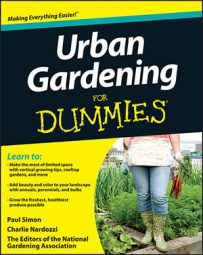When talking soil, a little knowledge goes a long way. And most important for urban farmers is recognizing your soil type and its health. Some soils are naturally fertile and need little altering, but others need an overhaul. Knowing where you stand with your soil helps you determine what fertilizers and amendments you need to add before you get started.
Urban soils have special considerations you need to know about. Certain contaminants like lead and other hazardous substances are potential pollutants in some city soils. Testing can tell you whether you have any cause for concern. Luckily, if your soil has elevated toxic levels, many tips and techniques can help fix the contaminated soil and build it back to optimum health.
Different soil types
Just like plants and people, soils have different characteristics that make them unique. Knowing the kind of soil you have helps you determine its strengths and weaknesses. While soil is composed of many elements, the place to begin is with your soil type. You just have to observe the composition of the soil’s particles.
The following three types of particles can make up your soil:
Clay: Clay is essential to your soil. Clay soil is naturally high in nutrients and holds moisture well, keeping your plants hydrated.
However, clay soil often gets a bad rap because of some of its characteristics. Wet clay soils stick to your shoes. And because the individual soil particles are so small, clay has smaller air spaces. As a result, it drains water slowly and is slow to warm up in spring. When dry, clay soil cracks and makes your garden look like the Mojave Desert.
Sand: Sand is the opposite of clay in many ways. Because of the large particle size, sand has lots of air spaces, so it drains water quickly and warms up fast. These characteristics make it ready to plant in spring sooner than clay. However, it’s also the first type of soil to dry out in summer and doesn’t hold nutrients as well as clay.
Silt: Silt is like the right bed in Goldilocks and the Three Bears. It has medium-sized particles, so it holds some water, but not too much. It holds some nutrients, but not as many as clay. It warms up fast in spring, but not as quickly as sand. A soil dominated by silt is a gardener’s friend.
Most soils are a combination of these three particles, but the particle type that dominates dictates many of the properties of your soil.
The ideal soil is 40 percent sand, 40 percent silt, and 20 percent clay. You’ll hear this mixture referred to as loam. It takes the best from each soil particle type. It has good water drainage and allows air to infiltrate the soil like sand, but it also holds moisture well and is fertile like silt and clay.
Loam is the ideal, but if your soil falls a little short, don’t worry. Through the addition of organic matter, you can create a loamier soil that has all the attributes you desire.
How to determine your soil type
You can try a few tests (from simple to more complex) to get a general idea of your soil type. Choose one or two tests to help you get an idea of your soil type.
The squeeze test
To do this test, be sure your soil is damp, but not soaking wet. Grab a small handful of the soil in your hand. Rub some of the soil between your fingers. If it feels gritty, it’s mostly sand. If it feels slick and slimy, it’s mostly clay.
The ribbon test
Take a handful of damp soil and make a ribbon by rolling the soil between your hands.
If you can form a ribbon and hold it vertically without it breaking, you have mostly clay soil. If you can make a ribbon, but it breaks off when you try to hold it up, you probably have somewhere between 25 and 50 percent clay in your soil. If you can’t make a ribbon at all, chances are your soil is more than half sand.
The jar test
The jar test is for the scientists in the crowd. It’s a bit more precise than the other tests. To do this test, take soil from a number of places in your garden and mix the samples together in a bucket. Scoop up a cup of your soil and follow these steps:
Let the soil dry out on a flat surface until it becomes crumbly.
Remove any roots, stones, or debris and crush it into a powder with a mortar.
Place a 1-inch-thick layer in the bottom of a quart-sized clear glass jar.
Fill the jar two-thirds full with water and add a pinch of salt (or 1 teaspoon of liquid dish detergent) to help the soil particles separate. Shake vigorously.
Let the solution settle into different layers.
The sand will settle quickly (within a few minutes) to form the bottom layer. A few hours later, the silt will settle. You should be able to see a visual difference between the large sand particles and the smaller silt particles. The clay may take days to settle out.
Measure the total amount of soil, and then measure each layer.
To determine the percentage of each soil type, you need to do a little math. If, for example, the total amount of soil is 1 inch deep and you had a 1/2-inch-thick layer of sand, your soil is 50 percent sand. If the next layer (silt) is 1/4 inch deep, you have 25 percent silt. The remaining 25 percent, then, is clay.

